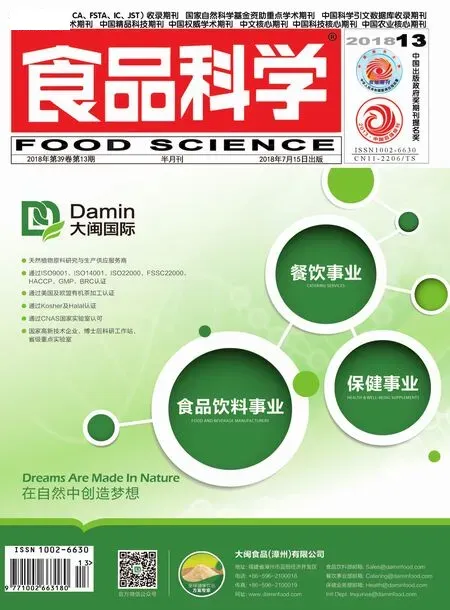Comparative Proteomics Study on Whole and Fresh-Cut Zizania latifolia during Storage at Room Temperature
2018-07-23WANGWeihuaJIANGLiCHENWeiWANGLibinLUOHaiboYUZhifang
WANG Weihua, JIANG Li, CHEN Wei, WANG Libin, LUO Haibo, YU Zhifang,
(1. College of Food Science and Technology, Nanjing Agricultural University, Nanjing 210095, China;2. College of Biological & Environmental Sciences, Zhejiang Wanli University, Ningbo 315100, China;3. Faculty of Food Science, Zhejiang Pharmaceutical College, Ningbo 315100, China)
Abstracts: In order to explore the molecular mechanism by which fresh-cut handling accelerates the senescence and quality deterioration of Zizania latifolia, the dynamic proteome changes of whole (control) and fresh-cut Z. latifolia during storage at room temperature (25 ℃) for 0, 3 and 5 days were investigated by using two-dimensional electrophoresis(2-DE). Approximately 660 protein spots were detected on the gels. Totally 39 spots showed a significant (P < 0.05)change in protein abundance based on 2.0-fold difference of which 35 were successfully identified by matrix-assisted laser desorption/ ionization time of flight mass spectrometry compared to the whole Z. latifolia. They could be categorized into seven functional groups, including signal transduction (8.6%), metabolism (22.9%), cell structure (8.6%), stress response and defense (31.4%), protein synthesis (11.4%), senescence (5.7%), and unclear functional proteins (11.4%). During storage,the expressions of 14 spots increased while the other 21 were down-regulated in the whole stem. Meanwhile, six spots(plant basic secretory protein, adenosine kinase, C2 domain, class III peroxidases, LbH_gamma_CA_like, and small Rasrelated GTP-binding protein), which were down-regulated in whole Z. latifolia, were up-regulated in fresh-cut Z. latifolia during storage, suggesting that these proteins may play important roles in the response to wounding stress. Also, fresh-cut significantly promoted the tendency for 14 up-regulated and other 15 down-regulated proteins. These results imply that the promotion of senescence and quality deterioration of Z. latifolia after fresh-cut processing may be due to the production and transduction of wounding signals, the acceleration of carbohydrate and nucleotide catabolism, the disorder of energy homeostasis and the enhancement of free radical damage, as well as the degradation of cell structure.
Keywords: Zizania latifolia; fresh-cut; senescence; quality deterioration; proteomics
Zizania latifolia (Griseb.) Turcz. ex Stapf, botanically different from the three species (Z. aquatica, Z. palustris and Z. texana) grown in North America, is a perennial aquatic grass belonging to tribe Oryzeae of the grass family(Poaceae) in China[1]. Z. latifolia grows along the littorals of freshwater lakes, streams, marshes and pools[2]. It is usually parasitized by the smut fungus (Ustilago esculenta P. Henn.),which stimulates enlargement of the culms of the grass[3-4].The enlarged infected culms have been eaten as a vegetable in China since the l0thcentury, commonly called Jiaobai,Jiaosun, Gusun, Gushou or Gaosun[5]. Because of its highly nutritional and economic value, the vegetable has been widely cultivated in rice fields of South China.
Z. latifolia is very suitable to be processed into fresh-cut product. It is usually cut into cubes, slices or shreds before marketing[6]. However, fresh-cut operations may accelerate the senescence and quality deterioration triggering cut surface browning, tissue lignification, shriveling, microbial contamination, off-flavor, respiratory rate, cellulose and lignin contents increase, which would reduce the shelf life of fresh-cut Z. latifolia to 2-3 days at room temperature[6].Therefore, clarification of the mechanisms involved in senescence and quality deterioration is of great importance to extend the shelf life of fresh-cut products.
Previously, the physiological and biochemical responses in Z. latifolia after fresh-cut operation have been investigated.In general, fresh-cut processing operations destroy the integrity of Z. latifolia, which in turn promote a faster physiological deterioration and biochemical changes such as respiratory activity, ethylene production, reactive oxygen species and malondialdehyde accumulation,lignification and antioxidant-related enzymes changes etc., thus accelerating the rate of senescence and quality deterioration[7]. Nevertheless, these researches mainly focused on wounding stress-induced changes at physiological and biochemical levels.
Fresh-cut products, which are subjected to mechanical damage by cutting operations, are still living organisms.Proteins play crucial roles in the structure and function of all living cells together with nucleic acids, carbohydrates and lipids, forming the biochemical basis of life[8]. Currently,proteomic approaches are being extensively used in fruits and vegetables to gain understanding on the mechanisms related to ripening and regulation[9], senescence[10], stress response[6]and preservation[11-12]. Our previous studies showed that the senescence of postharvest Z. latifolia during storage at 1 ℃ may be a consequence of multi-action,comprising the regulation of material metabolism, change of energy metabolism pathway, decline of reactive oxygen scavenging capacity and degradation of cell structure[10]. In addition, we analyzed the changes in the protein profile of Z. latifolia during refrigerated (1 ℃) storage. Results showed that 25 proteins differentially expressed and identified,with their functions mainly concentrated on cell structure,stress response and defense, and senescence[6]. However, the molecular mechanism of senescence and quality deterioration in fresh-cut Z. latifolia still not well understood. Also, there is limited information available on the wounding-responsive proteins occurring in the vegetable tissues after fresh-cut operation during storage at room temperature.
The objective of this study was to evaluate the changes in protein profile between whole and fresh-cut Z. latifolia during storage at room temperature (25 ℃) for exploring the possible molecular mechanism that fresh-cut operation accelerates senescence and quality deterioration of Z. latifolia.
1 Materials and Methods
1.1 Materials and Reagents
Fresh Z. latifolia at mature stage were hand-harvested from a commercial farmland in Yixing, Jiangsu, China.
Ethanol, hydrochloric acid, sucrose, mannitol, glycine,L-cysteine, tris-aminomethane, ethylenediaminetetraacetic acid, bovine serum albumin, polyvinylpyrrolidone, Coomassie brilliant blue G-250 and bromophenol blue Nanjing Shoude Testing Devices and Materials Co., Ltd. (China); Sodium dodecyl sulfate, trichloroacetic acid, ammonium persulfate,N,N,N’,N’-tetramethyldiethylamine, trypsin Promega Corporation (USA); Urea, thiourea, 3-((3-cholamidopropyl)dimethylammonium)-1-propanesulfonate, dithiothreitol,iodoacetamide and IPG buffer Sigma-Aldrich Co. (USA).
1.2 Instruments and Equipments
SPX-320 intelligent biochemical incubator Ningbo Jiangnan Instrument Factory (China); KQ-300DB ultrasonic cleaning machine Kunshan Ultrasonic Instrument Co.,Ltd. (China); FRESCO 17 micro high-speed refrigerated centrifuge Thermo Fisher Scientific Inc. (USA); AJ-30i high-speed refrigerated centrifuge Beckman Instruments Inc. (USA); Versdoc 3000 scanner Bio-Rad Laboratories Inc. (USA); TripleTOF 5600 system AB Sciex Inc. (USA).
1.3 Methods
1.3.1 Sample preparation
18 kg Z. latifolia with uniform size and the absence of visible defects, were selected, rinsed with tap water, and then randomly divided into two groups. For the first group, about 5 cm were removed from each end of the stems after peeling,then the remainder (mean length (5.00 ± 0.26) cm) were cut into slices of 3-5 mm thickness with a sharp stainless steel knife. The second group without cutting operation was acted as the control. The slices and the whole stem were then packaged into polyethylene plastic bags (thickness: 15 μm,size: 40 cm × 60 cm) with the mass of 400 g (fresh-cut Z. latifolia) and 1 kg (control), respectively. 9 bags per treatment were then stored at 25 ℃ for 0, 3 and 5 d,respectively. Samples (3 bags per treatment) were taken at different storage time, respectively, frozen in liquid nitrogen,and then stored at -20 ℃ until further analysis. For the control, the samples were peeled and removed 5 cm from each end of the stems before being frozen in liquid nitrogen.
1.3.2 Protein extraction and 2-DE analysis
Protein extraction and two-dimensional electrophoresis(2-DE) were carried out as described earlier[6]. Three biological replicates were performed for each storage time.
1.3.3 Image analysis
The gels were scanned using a Versdoc 3000 scanner at 300 dpi and saved as the GSC image files. Image analysis of each gel was performed using the PDQuest 2-DE analysis software (Version 8.0.1).
1.3.4 Tryptic digestion spots
Spots showing statistically significant changes and above a 2-fold threshold were carefully excised from the gels and then digested with trypsin according to the method described by Luo Haibo et al[6].
1.3.5 Identification of proteins by MALDI-TOF/TOF and database search
Protein identification was performed with matrix-assisted laser desorption/ionization time of flight mass spectrometry(MALDI-TOF/TOF). The functional classification of the identified proteins was annotated using the database at http://uniprot.org/uniprot. For protein accessions identified by MASCOT that had no functional annotation, a function was assigned via BLASTP searches of the corresponding protein accessions.
2 Results and Analysis
2.1 2-DE analysis of whole and fresh-cut Z. latifolia during storage at 25 ℃
During storage, the symptoms of senescence and quality deterioration in both whole and fresh-cut Z. latifolia were gradually severe including shell etiolation, surface browning,and tissue hollowness in whole Z. latifolia as well as cutting surface browning, and tissue lignification in fresh-cut Z. latifolia (Fig. 1).
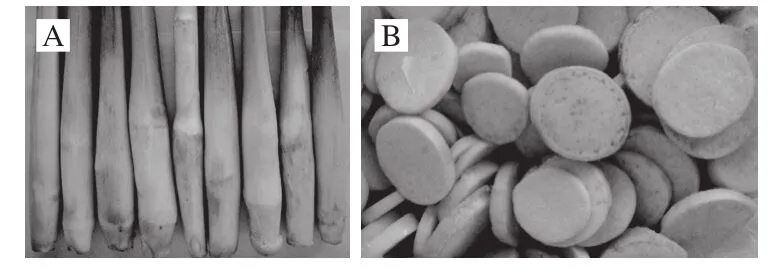
Fig. 1 Representatives of whole (A) and fresh-cut (B) Z. latifolia after 3 days of storage at 25 ℃
The proteins from whole and fresh-cut Z. latifolia during storage were extracted and separated by 2-DE. The 2-DE maps were obtained using isoelectric focusing (IEF) on immobilized pH gradient (IPG) gels (17 cm, pH 4-7)followed by sodium dodecyl sulfate-polyacrylamide gel electrophoresis (SDS-PAGE) on 12% polyacrylamide gels before staining with Coomassie brilliant blue G250(Fig. 2). The 2-DE gels were matched and analyzed by PDQuest 2-DE analysis software (Version 8.0.1).Approximately 660 protein spots were detected on the gels.Quantitative image analysis of three replicates of each sample revealed that 39 protein spots showed a more than 2.0-fold increase/decrease in protein abundance in at least one storage time point compared to the whole Z. latifolia of corresponding time point. The specific distribution in Fig. 3 and the magnified views of some differentially expressed proteins were shown in Fig. 4.
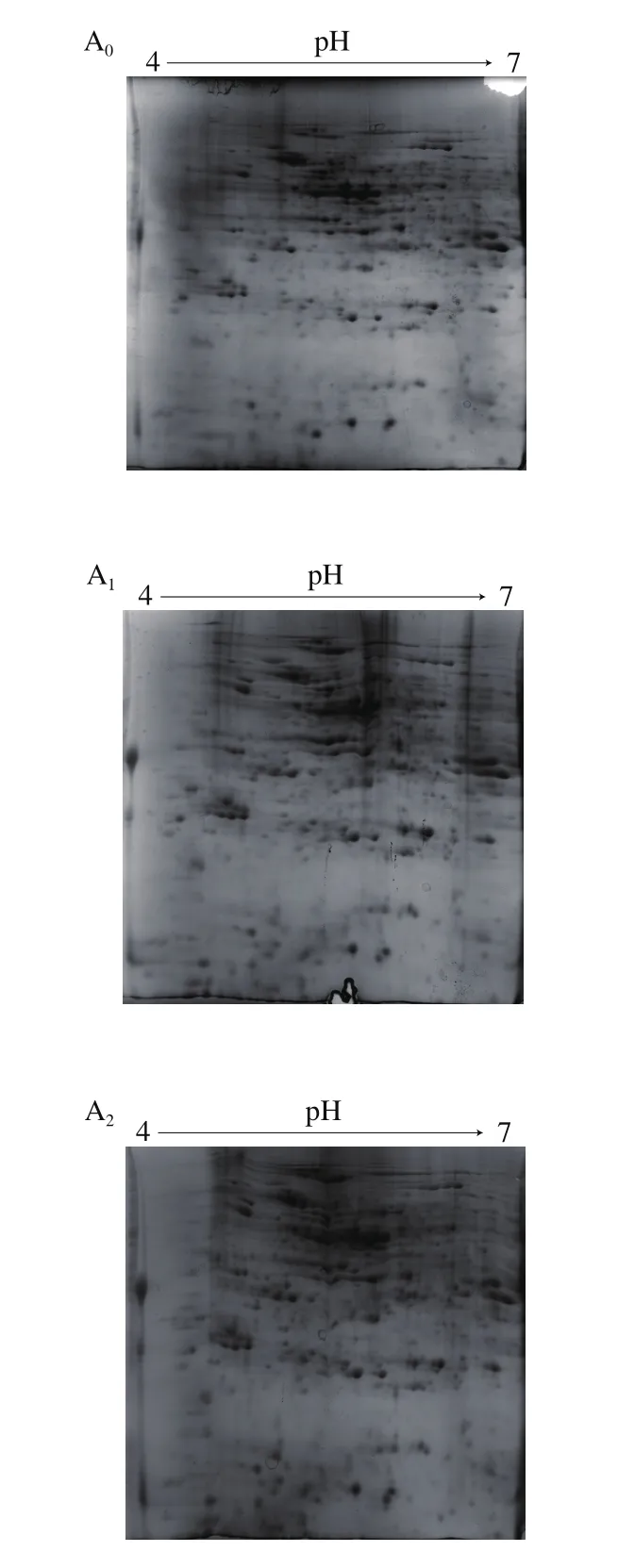
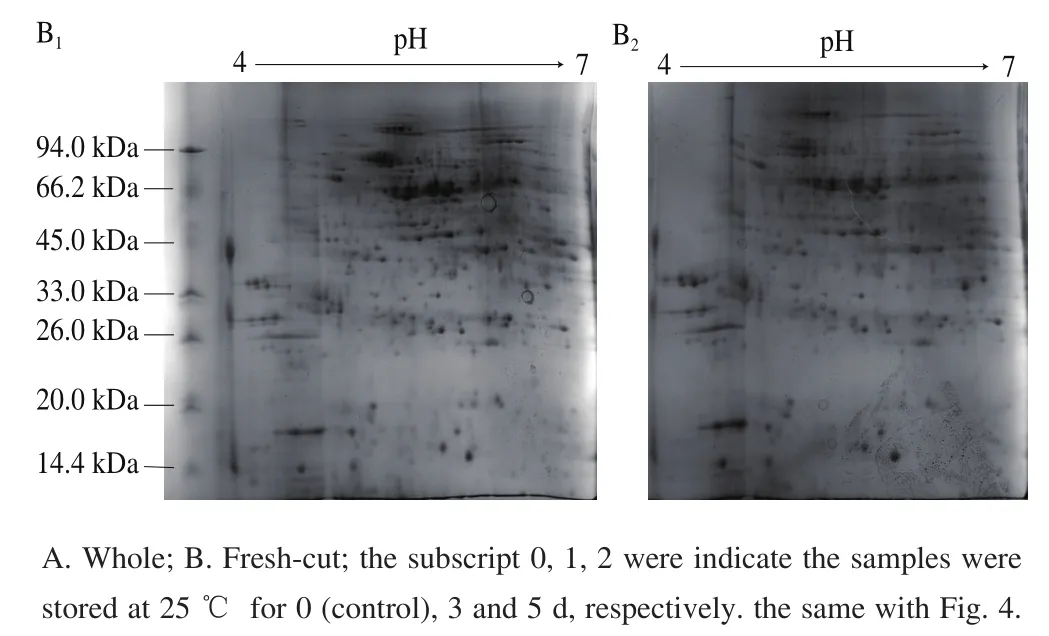
Fig. 2 Representative 2-DE gels of whole and fresh-cut Z. latifolia during storage at 25 ℃
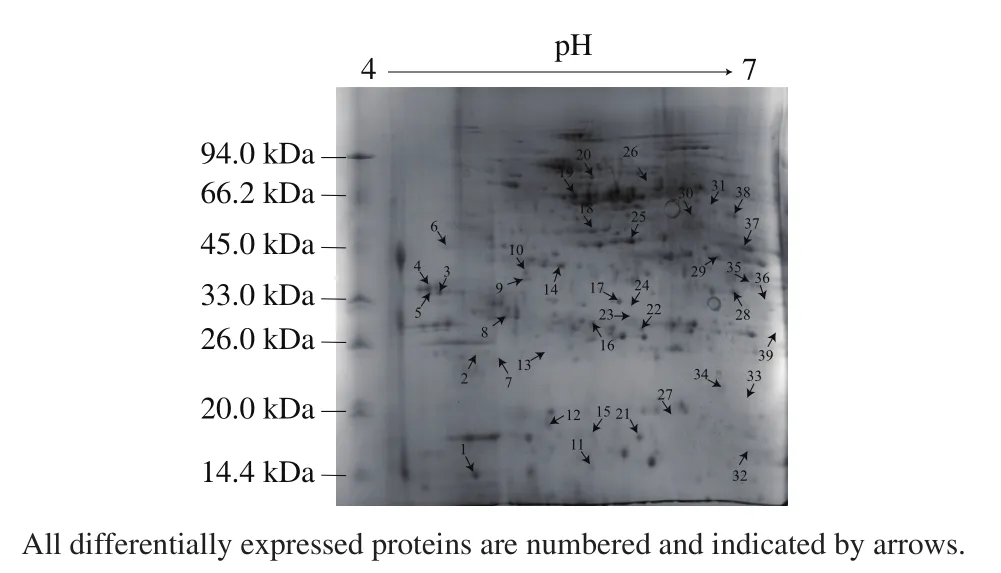
Fig. 3 2-DE reference map of Z. latifolia in Fig. 2B1
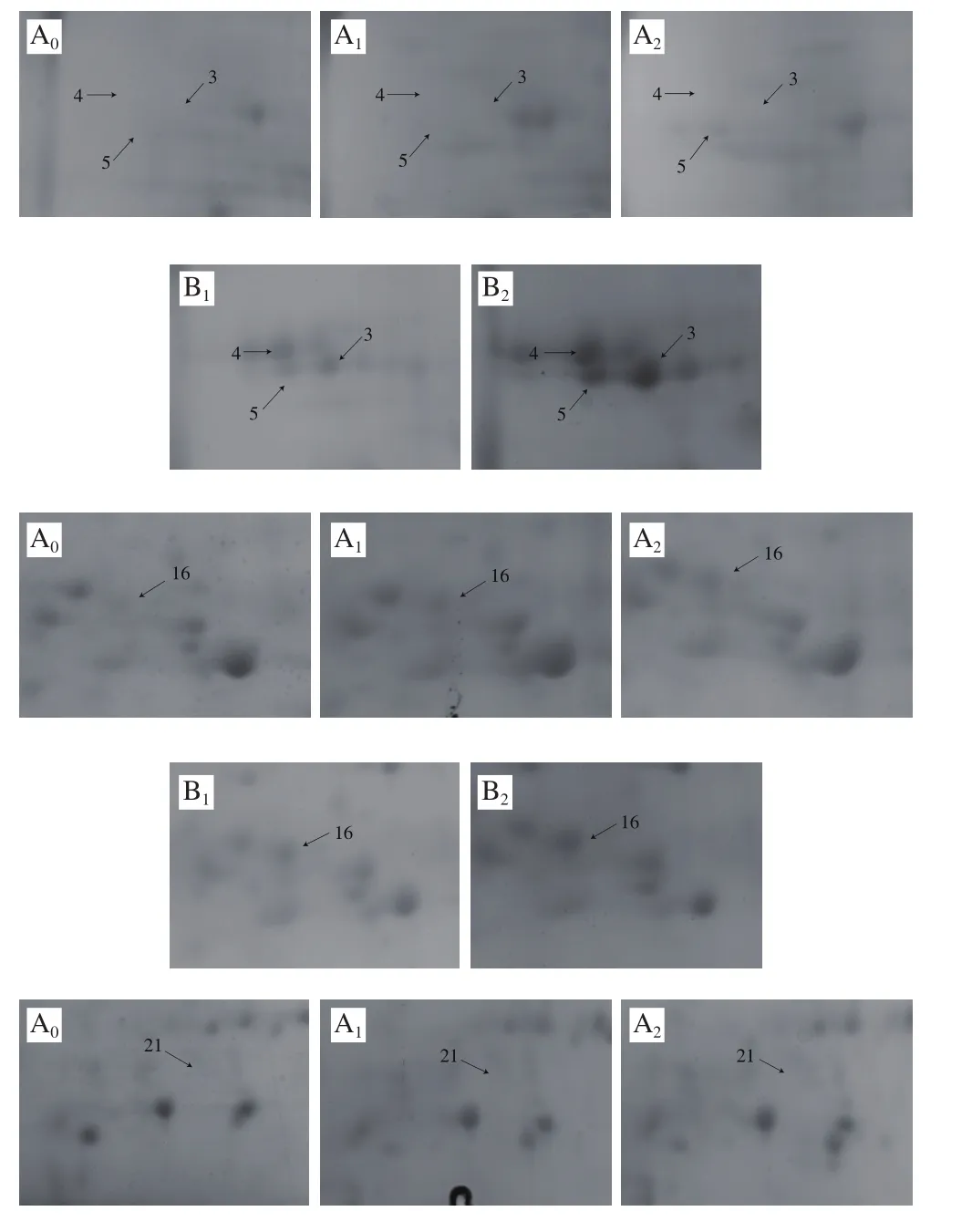
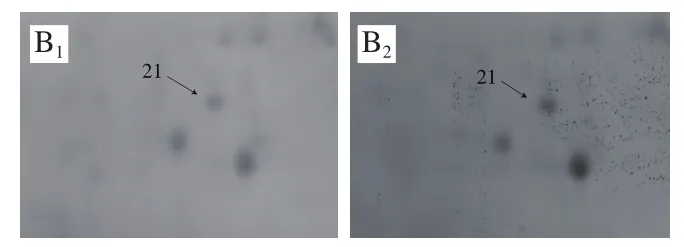
Fig. 4 Five times magnified views of some differentially abundant proteins marked in Fig. 2
2.2 Identification by mass spectrometry and functional analysis of differentially expressed proteins
35 out of 39 spots which significantly changes(P < 0.05), were successfully identified and could then be classified into seven functional categories listed in Fig. 5,including signal transduction (8.6%), metabolism (22.9%),cell structure (8.6%), stress response and defense (31.4%),protein synthesis (11.4%), senescence (5.7%), and unclear functional proteins (11.4%). Cluster analysis was carried out on differentially expressed proteins from day 0 to day 5 (Fig. 6),revealing a dynamic proteome profile shift of Z. latifolia at different time points during storage at 25 ℃.
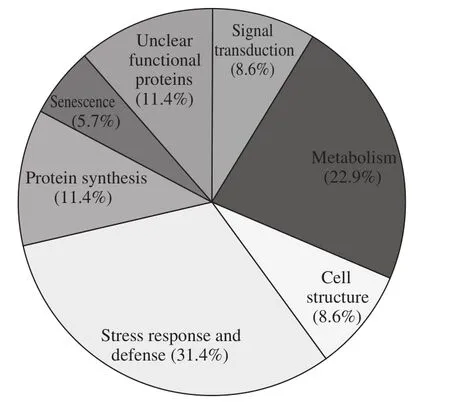
Fig. 5 Functional distribution of identified proteins expressed differentially covering seven protein groups categorized according to their putative functions
As shown in Table 1, 14 out of the 35 differentially expressed and identified proteins were up-regulated while the others were down-regulated during the storage of whole Z. latifolia. For the up-regulated proteins, spot 14(fructokinases), spot 17 (glycosyl hydrolases family 17), spot 19 (2,3-bisphosphoglycerate-independent phosphoglycerate mutase) and spot 26 (diphosphonucleotide phosphatase 1)were related to metabolism; spot 1 (profilin) to cell structure;spot 3 (β-1,3-glucanase precursor), spot 4 (glucan endo-1,3-beta-glucosidase), spot 5 (β-1,3-glucanase precursor), spot 12 (universal stress protein family), spot 21 (thaumatin-like protein isoform 2), spot 22 (glutathione S-transferase) and spot 28 (β-1,3-glucanase) were related to stress response and defense; spot 16 (cysteine protease) and spot 23 (papain-like cysteine proteinase) were related to senescence.

Fig. 6 Cluster analysis of whole and fresh-cut Z. latifolia during storage at 25 ℃
For the down-regulated ones, spot 8 (14-3-3-like protein), spot 10 (C2 domain) and spot 38 (small Ras-related GTP-binding protein) were related to signal transduction;spot 6 (adenosine kinase), spot 20 (transketolase), spot 30(enolase) and spot 37 (isocitrate dehydrogenase NADP+)were related to metabolism; spot 18 (actin) and spot 27 (actin depolymerisation factor/cofilin-like domains) were related to cell structure; spot 2 (plant basic secretory protein), spot 24(class III peroxidases), spot 33 (dehydroascorbate reductase)and spot 34 (chitinase class I) were related to stress response and defense; spot 11 (glycine-rich RNA-binding protein),spot 13 (putative chaperonin 21 precursor), spot 15(putative ribosomal protein S12) and spot 31 (RNA recognition motif) were related to protein synthesis;furthermore, the functions of spot 9 (DREPP plasma membrane polypeptide), spot 29 (WD40 domain), spot 35 (LbH_gamma_CA_like) and spot 36 (ricinB_lectin_2)were still unclarified.

Table1 Differentially expressed proteins of whole and fresh-cut Z. latifolia during storage at 25 ℃
On the other hand, when compared to control tissue, the responses of 29 proteins during storage were enhanced after fresh-cut operations. However, the expressions of spot 2, spot 6, spot 10, spot 24, spot 35,and spot 38, which decreased during storage of whole Z. latifolia, were up-regulated after fresh-cut operation,indicating that they might play vital roles in response to wounding stress.
3 Discussion
During senescence and quality deterioration of Z. latifolia, a variety of physiological and biochemical responses occurred, in association with the changes in the protein profile, which could be influenced by a variety of internal or external factors. In this study, changes in abundance 35 proteins between whole and freshcut Z. latifolia during storage were observed based on 2.0-fold difference. They are suggested to play roles in signal transduction, carbohydrate metabolism, nucleotide metabolism, cell structure, stress response and defense,protein synthesis, as well as senescence.
3.1 Identified proteins related to signal transduction
Signal transduction is the process which begins with the binding of specific ligands to receptors located at the surface of the plasma membrane, thus causing an intracellular metabolic change[13]. Three proteins (spot 8, spot 10,spot 38) involved in signal transduction were identified.14-3-3-like proteins (spot 8) are important regulators of signal transduction pathways through binding to multiple functionally diverse signaling proteins such as kinases,phosphatases and transmembrane receptors[14-15]. C2 domains(spot 10) are usually Ca2+-dependent membrane-targeting module found in many cellular proteins, functions in membrane trafficking or signal transduction[16]. Small Rasrelated GTP-binding protein (spot 38) has diverse biological functions, such as nuclear transport, DNA replication, spindle formation during mitosis and cell division[17]. All of them decreased during the storage of whole Z. latifolia; however,spot 10 and spot 38 were up-regulated by fresh-cut operation,suggesting that signal transduction was enhanced.
3.2 Identified proteins related to metabolism
An important strategy for plant to adapt different abitic/biotic stresses is through the regulation of physiological metabolism[18]. Two proteins involved in nucleotide metabolism were identified: adenosine kinase (AK, spot 6) is involved in the purine salvage pathway and plays a key role in the prevention of adenosine accumulation and supports the metabolic cycling of adenosine[19], while diphosphonucleotide phosphatase 1 (DPP, spot 26) catalyzes the hydrolysis of a wide range of activated phosphoric acid mono- and di-esters and anhydrides at pH in the range of 5 to 6[20]. In the present study, the expressions of both AK and DPP were up-regulated by fresh-cut operation at 3rdand/or 5thday of storage,indicating that nucleotide catabolism was accelerated.
Fructokinases (FRKs, spot 14), glycosyl hydrolases family 17 (GHF, spot 17), 2,3-bisphosphoglycerateindependent phosphoglycerate mutase (BIPM, spot 19),transketolase (TK, spot 20), enolase (spot 30) and isocitrate dehydrogenase NADP+(IDH, spot 37) play important roles in carbohydrate metabolism[21]. Of these, GHF belongs to the glycosyl hydrolase family and catalyzes the hydrolysis of polysaccharides to monosaccharides[22]. Fresh-cut significantly increased the expression of GHF during storage,suggesting an enhanced carbohydrate catabolism. FRKs,BIPM and enolase are involved in glycolysis[23], IDH is the key enzyme in the tricarboxylicacidcycle acid (TCA)cycle[24], while TK is the key enzyme of the pentose phosphate pathway[25]. Glycolysis, TCA cycle and pentose phosphate pathways provide energy and inter-conversion building blocks for metabolites synthesis[11]. The downregulated expressions of these proteins after fresh-cut operation implied that the supplyment of energy decreased.
3.3 Identified proteins related to cell structure
The plant cell walls are crucial for providing shape to many different cell types, forming the interface between adjacent cells, as well as resisting the invasion of pathogens[26]. Three proteins related to cell structure were identified, including profilin (spot 1), actin (spot 18) and actin depolymerisation factor/cofilin-like domains (ADF,spot 27). Actin is a ubiquitous protein involved in the formation of filaments that are a major component of the cytoskeleton[24]. Profilin may link the cytoskeleton with major signaling pathways by interacting with components of the phosphatidylinositol cycle and Ras pathway, which plays a central role in the assembly of branched actin filament networks[27], while ADF acting as a family member of essential eukaryotic actin regulatory proteins could enhance the turnover rate of actin and interact with actin monomers as well as actin filaments[28]. In contrast to actin and profilin,the expression of ADF increased in fresh-cut Z. latifolia during storage, suggesting that fresh-cut accelerated the cell structure disassembly, which was further validated by cell ultrastructural observation using transmission electron microscope (unpublished data).
3.4 Identified proteins related to stress response and defense
Stress response, which is mediated via profound changes in gene expression, causes changes in composition of plant transcriptome, proteome and metabolome[29]. Of the eleven stress response and defense proteins, eight were related to disease resistance. Plant basic secretory protein (BSP, spot 2)is believed to be part of the plants defense mechanism against pathogens[30], β-1,3-glucanase precursor (spot 3 and 5), glucan endo-1,3-β-glucosidase (spot 4) and β-1,3-glucanase (spot 28) may provide a degree of protection against microbial invasion through their ability to degrade fungal cell wall polysaccharides[31], universal stress protein family (USP, spot 12) is a small cytoplasmic bacterial protein whose expression is enhanced when the cell is exposed to stress agents[10],thaumatin-like protein isoform 2 (TLP, spot 21) plays a role in host defense and developmental processes[32], while chitinase class I (spot 34) catalyzes the hydrolysis of the β-1,4-N-acetyl-D-glucosamine linkages in chitin polymers of fungal cell walls[33]. The significant up-regulation of these proteins, except chitinase class I, provide a good indication that fresh-cut induced the improvement of anti-pathogen capability compared to the control.
Senescence is a vital aspect of vegetable life cycles, and directly affects vegetable quality and resistance to pathogens.Reactive oxygen species (ROS), as the primary mediators of oxidative damage in plants, are involved in senescence[10].Furthermore, superoxide dismutase (SOD), ascorbate peroxidase (APX), dehydroascorbate reductase (DHAR),glutathione S-transferase (GST) and peroxidases (POD) are antioxidant enzymes related to ROS metabolism[34]. In this study, three ROS metabolism related proteins identified were GST (spot 22), class III peroxidases (PODIII, spot 24) and DHAR (spot 33). GST and DHAR are involved in the ascorbate-glutathione cycle, which has been regarded as one of the most important antioxidant pathways for hydrogen peroxide (H2O2) detoxification[34]. PODIII is responsible for the physiological function of indole-3-acetic acid degradation, lignin biosynthesis, wound healing,general stress response and pathogen defense as well as H2O2detoxification[24]. In previous studies, POD activity increased in fresh-cut Z. latifolia during storage at 1 ℃. This result was further validated by POD expression pattern in the present study. Based on these results, we speculated that ROS damage could be implicated in senescence and quality deterioration of fresh-cut Z. latifolia.
3.5 Identified proteins related to protein synthesis
The regulation of protein synthesis plays a key role in the control of cell growth, proliferation, and apoptosis[35]. In this study, four proteins involved in protein synthesis, namely glycine-rich RNA-binding protein (GRP, spot 11), putative chaperonin 21 precursor (C21P, spot 13), putative ribosomal protein S12 (RPS12, spot 15) and RNA recognition motif(RRM, spot 31) were identified. GRP is suggested to play a role in response to environmental stresses[36], C21P helps nascent peptide chain precursor reconciliation folded protein peptide chain folds into a protein having a biological function conformation[37], RPS12 located at the subunit interface is proposed to play critical roles in interacting with the tRNA substrates and the large subunit[38], RRM, a highly abundant domain of the proteins in eukaryotes, participates in posttranscriptional gene expression processes, including mRNA and rRNA processing, RNA export, and RNA stability[39]. All of these proteins were significantly down-regulated by freshcut during storage, indicating that fresh-cut accelerated the protein dissimilation in Z. latifolia.
3.6 Identified proteins related to senescence
Senescence, caused by pathogens, environmental stresses, or inherent physiological changes, is a collective term for the deteriorative changes in living organisms which lead to death. Two proteins, cysteine proteases (CPs, spot 16)and papain-like CPs (spot 23), were supposed to be related with the senescence. In this report, CPs (spot 16) and papainlike CPs (spot 23) significantly increased in both whole and fresh-cut Z. latifolia during storage. It is likely that the wounding stress caused by fresh-cut enhanced the protein catabolism, which may play a major role in senescence and quality deterioration of Z. latifolia.
3.7 The unclear functional proteins
Four spots subjected to mass spectrometry were identified as DREPP plasma membrane polypeptide (spot 9),WD40 domain (spot 29), LbH_gamma_CA_like (spot 35)and RicinB_lectin_2 (spot 36). Although they were searched by BLASTP matches of the corresponding protein accessions,their functions were still unclear. The expressions of spot 9, 29, and 36 showed similar expression pattern in both whole and fresh-cut Z. latifolia during storage; nevertheless,LbH_gamma_CA_like (spot 35), which was down-regulated in whole stem, increased in fresh-cut tissue during storage.These results suggested that LbH_gamma_CA_like might play directly/indirectly role in response to wounding stress.
4 Conclusions
This study demonstrated that when compared to integral stem, the dynamic proteome changes of 35 proteins identified were significantly altered after fresh-cut operation in association with the accelerated senescence and quality deterioration. Based on their functions, the possible mechanisms of fresh-cut operation accelerating senescence and quality deterioration of Z. latifolia might be due to: 1)enhancement of production and transduction of wounding signals; 2) enhancement of the carbohydrate, nucleotide and protein catabolism, but attenuation of the protein assimilation,glycolysis, TCA cycle and pentose phosphate pathways,thus reducing the energy supplement; 3) inducement of the expression of pathogenesis-related proteins and antioxidant enzymes; 4) acceleration of the cell structure disassembly.This study has put forward interpretable data and provided new perspectives on the mechanism of fresh-cut operations accelerating senescence and quality deterioration of Z. latifolia. However, further detailed investigation of these proteins’ specific roles and their functional correlation with wounding response should be performed to better understand the mechanism of fresh-cut operations accelerate senescence and quality deterioration.
